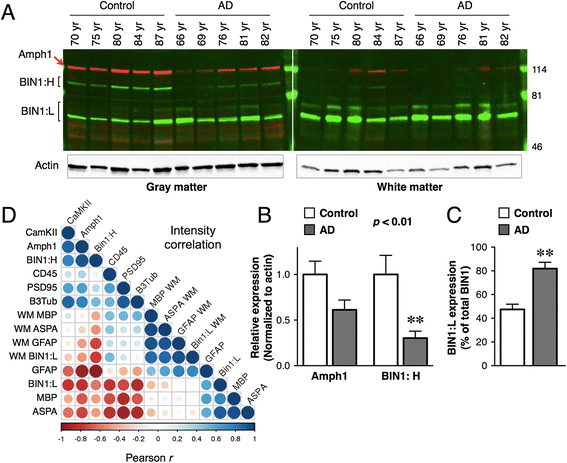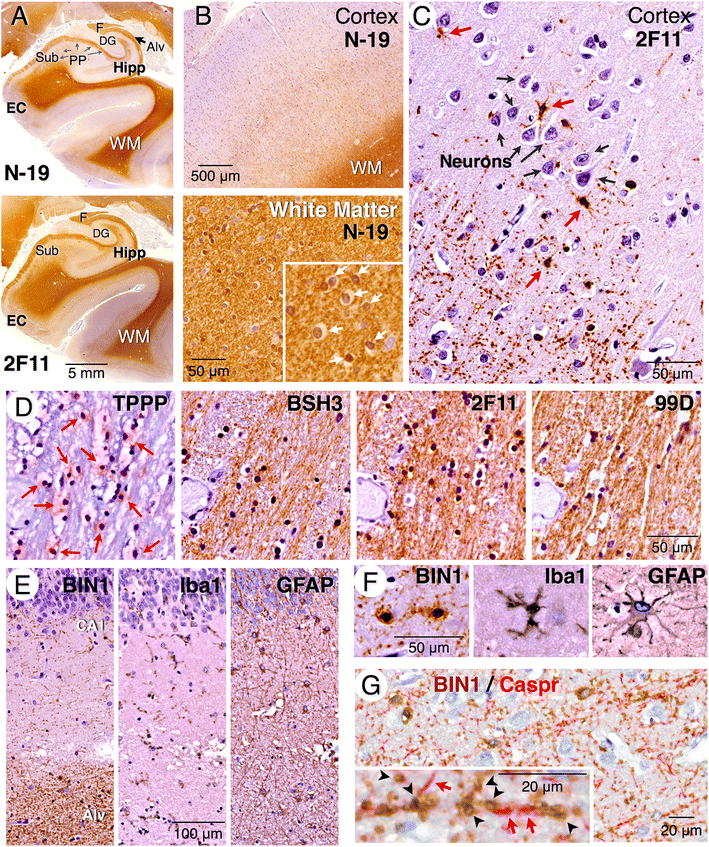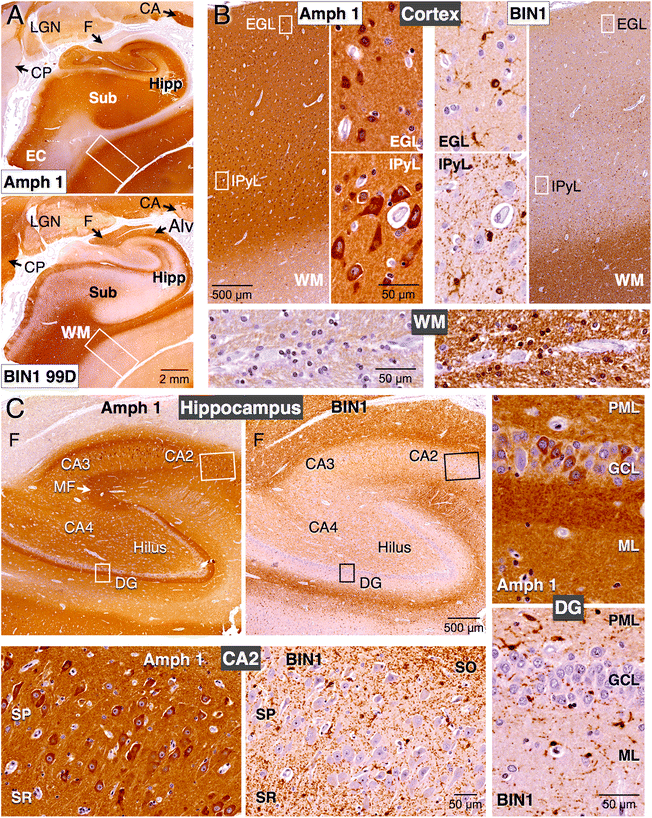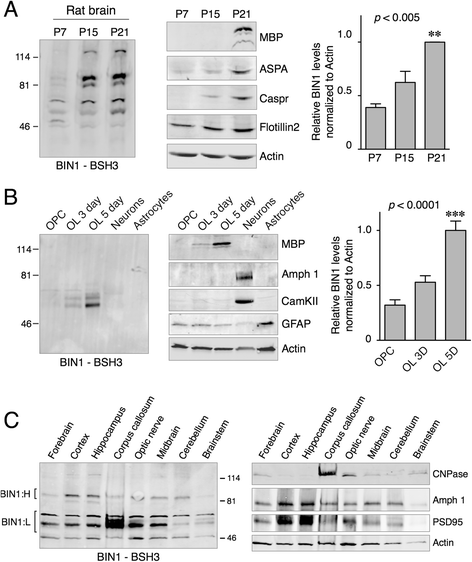Predominant expression of Alzheimer's disease-associated BIN1 in mature oligodendrocytes and localization to white matter tracts
- PMID: 27488240
- PMCID: PMC4973113
- DOI: 10.1186/s13024-016-0124-1
Predominant expression of Alzheimer's disease-associated BIN1 in mature oligodendrocytes and localization to white matter tracts
Erratum in
-
Correction: Predominant expression of Alzheimer's disease-associated BIN1 in mature oligodendrocytes and localization to white matter tracts.Mol Neurodegener. 2023 Oct 2;18(1):72. doi: 10.1186/s13024-023-00662-z. Mol Neurodegener. 2023. PMID: 37784204 Free PMC article. No abstract available.
Abstract
Background: Genome-wide association studies have identified BIN1 within the second most significant susceptibility locus in late-onset Alzheimer's disease (AD). BIN1 undergoes complex alternative splicing to generate multiple isoforms with diverse functions in multiple cellular processes including endocytosis and membrane remodeling. An increase in BIN1 expression in AD and an interaction between BIN1 and Tau have been reported. However, disparate descriptions of BIN1 expression and localization in the brain previously reported in the literature and the lack of clarity on brain BIN1 isoforms present formidable challenges to our understanding of how genetic variants in BIN1 increase the risk for AD.
Methods: In this study, we analyzed BIN1 mRNA and protein levels in human brain samples from individuals with or without AD. In addition, we characterized the BIN1 expression and isoform diversity in human and rodent tissue by immunohistochemistry and immunoblotting using a panel of BIN1 antibodies.
Results: Here, we report on BIN1 isoform diversity in the human brain and document alterations in the levels of select BIN1 isoforms in individuals with AD. In addition, we report striking BIN1 localization to white matter tracts in rodent and the human brain, and document that the large majority of BIN1 is expressed in mature oligodendrocytes whereas neuronal BIN1 represents a minor fraction. This predominant non-neuronal BIN1 localization contrasts with the strict neuronal expression and presynaptic localization of the BIN1 paralog, Amphiphysin 1. We also observe upregulation of BIN1 at the onset of postnatal myelination in the brain and during differentiation of cultured oligodendrocytes. Finally, we document that the loss of BIN1 significantly correlates with the extent of demyelination in multiple sclerosis lesions.
Conclusion: Our study provides new insights into the brain distribution and cellular expression of an important risk factor associated with late-onset AD. We propose that efforts to define how genetic variants in BIN1 elevate the risk for AD would behoove to consider BIN1 function in the context of its main expression in mature oligodendrocytes and the potential for a role of BIN1 in the membrane remodeling that accompanies the process of myelination.
Keywords: Alternative splicing; Alzheimer’s disease; Amphiphysin 1; BIN1; Immunohistochemistry; Isoform diversity; Late-onset Alzheimer’s disease; Multiple sclerosis; Myelination; Oligodendrocyte.
Figures









Similar articles
-
Aberrant accrual of BIN1 near Alzheimer's disease amyloid deposits in transgenic models.Brain Pathol. 2019 Jul;29(4):485-501. doi: 10.1111/bpa.12687. Epub 2018 Dec 27. Brain Pathol. 2019. PMID: 30506549 Free PMC article.
-
Intracellular clusterin interacts with brain isoforms of the bridging integrator 1 and with the microtubule-associated protein Tau in Alzheimer's disease.PLoS One. 2014 Jul 22;9(7):e103187. doi: 10.1371/journal.pone.0103187. eCollection 2014. PLoS One. 2014. PMID: 25051234 Free PMC article.
-
Bridging integrator 1 (BIN1) protein expression increases in the Alzheimer's disease brain and correlates with neurofibrillary tangle pathology.J Alzheimers Dis. 2014;42(4):1221-7. doi: 10.3233/JAD-132450. J Alzheimers Dis. 2014. PMID: 25024306 Free PMC article.
-
The Mechanistic Role of Bridging Integrator 1 (BIN1) in Alzheimer's Disease.Cell Mol Neurobiol. 2021 Oct;41(7):1431-1440. doi: 10.1007/s10571-020-00926-y. Epub 2020 Jul 27. Cell Mol Neurobiol. 2021. PMID: 32719966 Free PMC article. Review.
-
BIN1 in the Pursuit of Ousting the Alzheimer's Reign: Impact on Amyloid and Tau Neuropathology.Neurotox Res. 2023 Dec;41(6):698-707. doi: 10.1007/s12640-023-00670-3. Epub 2023 Oct 17. Neurotox Res. 2023. PMID: 37847429 Review.
Cited by
-
The Challenge to Search for New Nervous System Disease Biomarker Candidates: the Opportunity to Use the Proteogenomics Approach.J Mol Neurosci. 2019 Jan;67(1):150-164. doi: 10.1007/s12031-018-1220-1. Epub 2018 Dec 15. J Mol Neurosci. 2019. PMID: 30554402 Review.
-
Early Life Stress and Epigenetics in Late-onset Alzheimer's Dementia: A Systematic Review.Curr Genomics. 2018 Nov;19(7):522-602. doi: 10.2174/1389202919666171229145156. Curr Genomics. 2018. PMID: 30386171 Free PMC article. Review.
-
Altered DNA methylome profiles of blood leukocytes in Chinese patients with mild cognitive impairment and Alzheimer's disease.Front Genet. 2023 Jun 14;14:1175864. doi: 10.3389/fgene.2023.1175864. eCollection 2023. Front Genet. 2023. PMID: 37388929 Free PMC article.
-
Alzheimer's disease risk gene BIN1 induces Tau-dependent network hyperexcitability.Elife. 2020 Jul 13;9:e57354. doi: 10.7554/eLife.57354. Elife. 2020. PMID: 32657270 Free PMC article.
-
Beyond Clathrin: Decoding the Mechanism of Ultrafast Endocytosis.Physiology (Bethesda). 2025 Sep 1;40(5):0. doi: 10.1152/physiol.00041.2024. Epub 2025 Mar 10. Physiology (Bethesda). 2025. PMID: 40062769 Free PMC article. Review.
References
-
- Butler MH, David C, Ochoa GC, Freyberg Z, Daniell L, Grabs D, Cremona O, De Camilli P. Amphiphysin II (SH3P9; BIN1), a member of the amphiphysin/Rvs family, is concentrated in the cortical cytomatrix of axon initial segments and nodes of ranvier in brain and around T tubules in skeletal muscle. J Cell Biol. 1997;137:1355–1367. doi: 10.1083/jcb.137.6.1355. - DOI - PMC - PubMed
Publication types
MeSH terms
Substances
Grants and funding
LinkOut - more resources
Full Text Sources
Other Literature Sources
Medical
Molecular Biology Databases

